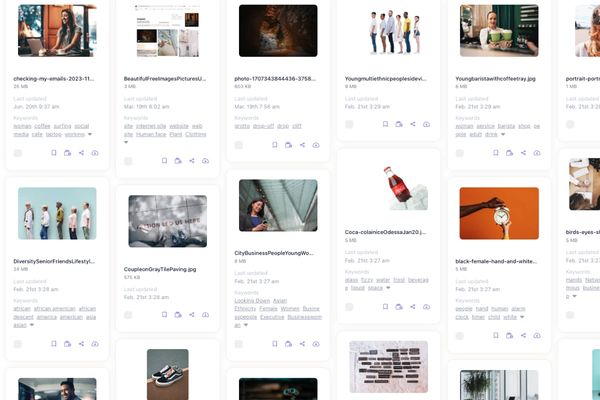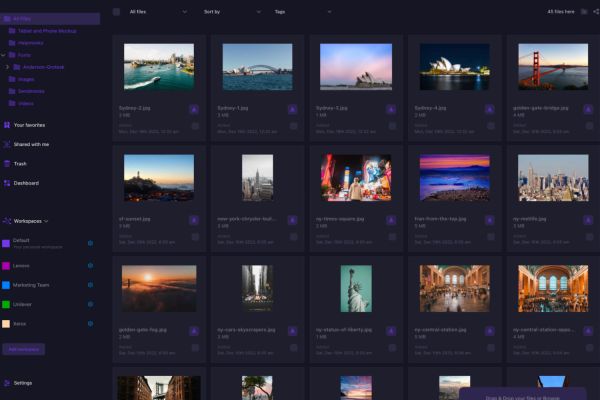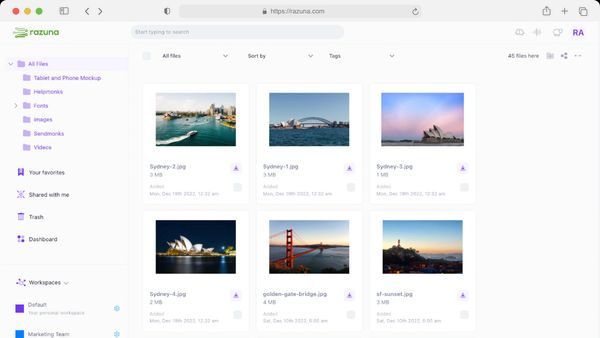
What Are Digital Assets?
All files that your business uses is a type of digital asset. This guide explains the various types, what makes them crucial, and how best to manage them.
Read nowDo you have a digital asset management strategy for transitioning to DAM software? How about switching from one software product to another? If not, you could end up with a disjointed program that doesn't work for your brand asset management.
Digital assets are not an exception to the rule regarding asset management. Companies are creating more digital assets than physical assets due to the massive surge in digital media. Images, videos, blogs, and digital products are examples of these.
If you are creating these digital assets, it would be best to manage them in a streamlined manner that maintains security. Plus, you'll need collaboration flexibility while allowing your teams to categorize, organize, and locate assets on demand.
Storing, accessing, and sharing these assets when needed would be extremely difficult without structure.
You can make a move easier by moving through the process in stages and establishing reasonable expectations. Finding a DAM company to assist you with migration and onboarding is also beneficial.
Are you looking for a company with a proven track record that offers a user-friendly digital asset management solution? Keep reading to learn more about digital asset management implementation.
When brands decide to move assets from one platform to another, mistakes can happen if you're not careful. They might pull outdated content for new marketing strategies and publish assets on the wrong channels. Errors like these lead to repurposing outdated collateral and going off-brand, causing your company to repurpose outdated collateral and go off-brand.
If this happens, your team members aren't able to work effectively.
With a data asset management strategy, you'll have the opportunity to plan and review every aspect of the transition. You can decide on a platform that is right for your brand. It also gives you time to prepare your teams for implementation.
Don't overlook the importance of planning. Include the following in your plans:
Keep your digital asset management system up to date as your business grows. Here are ten steps to ensure your strategy for a successful digital asset management implementation project plan.

You must choose the best digital asset management software for your company's needs before creating your digital asset management implementation project plan. To do this, you must first know how and where your assets are currently being stored. Reviewing your current processes will help you ask the right questions during the selection process.
Don't become confused by the numerous digital asset management software options. Most of them have features and functionality comparable to one another. Still, they all have some differences in appealing to various end users.
For example, one company may have digital asset management software that promotes simplicity for small teams. Another provider might target companies requiring software to house complex digital asset portfolios.
After you've reviewed two or three products, you might lose sight of why you started this research journey. Stay focused and answer these questions as they pertain to your company.
What issues are your teams currently experiencing regarding storing and using brand collateral?
Creating digital assets to sell and market your business is a big deal. Your marketing team needs easy access to files and a storage system that isn't cumbersome.
You know your current digital asset management requirements better than anyone outside your company. Host a team meeting to get input on the new system. Also, ask team members what will assist them with digital asset creation.
Consider the features your teams currently use and how they stack up against those of other DAM systems when switching DAM software. Why are you leaving your DAM behind? What aspects of your current system do you enjoy, and what aspects do you wish to modify?
What is hindering your current workflow?
There is a multitude of things that could potentially hinder a marketing team's workflow. Creating a digital asset management implementation project plan before selecting new software will help address any issues.
Ask team members to brainstorm the issues and submit a list of objectives. The list will help as you review each provider's list of system capabilities.
Also, consider the size of your company, the people using the software, and the resources available to get everyone on board. If workflow concerns aren't addressed, you'll have to scale back and continue using the same procedures as before while you work through the rollout.
Purchasing software and not implementing it correctly is a waste of resources.
Companies with small teams and limited funding might not have someone to assist with onboarding. If you need help with onboarding, ask the DAM provider upfront if they offer assistance.
For smaller companies, comprehensive online tutorials may substitute for hiring a consultant. Seek a team member with training experience to lead the process. Still, you may need access to someone within the providers' organization to answer complex questions.
After your digital asset management software is up and running, you may experience issues. How do you want your DAM provider to support your teams and stakeholders in solving issues that arise?
It doesn't mean there is a defect with the software. Sometimes your teams might experience unique circumstances that require assistance from the DAM provider.
You want to ask about help desk services. Is the service provided 24/7? Are their reps available to speak with team members?
As we rapidly move into the age of AI technology, can team members access support through chats or online libraries?
Remember, you'll need a DAM provider that provides help if you need software for complex assets. Not having time to train users quickly or offer support when issues arise will impact your bottom line.
The most significant thing is to talk to the DAM provider you are interested in before purchasing their product. Ensure that you select the appropriate DAM, ask questions, and have a game plan.

Do you store thousands of assets in multiple locations? Are there outdated or duplicate assets occupying space? Does your library have a clear hierarchy of folders? Although there are numerous digital assets, for marketing purposes, they include the following:
You risk compromising your digital asset creations if you store thousands of assets in multiple locations. Some of these assets could be outdated or duplicate assets occupying space. For this reason, your library needs to have a clear hierarchy of folders.
Find out which assets your teams use the most and which they won't use for a while. Get rid of any assets that your teams no longer need. This process will assist you in several ways.
You will understand how much help you need and the time needed to clean up your files. Prioritize assets that get used frequently. Next, migrate digital content not used often to a separate section.
This process will allow you to save content that doesn't need to be used consistently but remains accessible for future use.
Next, check that your DAM system contains all the media files your teams require. Get rid of any content you no longer need or want. Learn about your folders and naming structure to make changes to support your digital asset management strategy.
As your teams advance, save time by quickly cleaning up during future audits. It will save time and reduce exposure to media losses.
At this point, you don't need to transform your brand asset library completely. It will be staged during the digital asset management implementation project plan. However, it is recommended that you do the following:
Assess if a digital file is out-of-date or a duplicate. For duplicates, decide which is the most current file. Next, determine which version of duplicate assets you should merge or delete.
When dealing with out-of-date content, you'll need to determine if there is a need to hold on to the asset.
Another aspect of digital asset creation is your file naming system.
If the naming convention is organized, teams can locate assets quickly. But if you let everyone decide how to name a file, the system will only become chaotic.
Your workflows and the kinds of content you produce will now guide your file naming convention. In general, you should concentrate on making sure that the names of the files are simple to comprehend. Make it clear which asset is the most recent and pertinent to the project.
Change file names whenever necessary. Your DAM can pull the appropriate assets when you search for them.
Search optimization will apply as long as the name of your file follows some logic. For example, an image of a yellow sweater is labeled "Yellow Sweater."
Remember that digital asset management software doesn't require strict naming conventions. Creating digital assets to sell remains in your control.
You're ready to plan how you want to organize your company's assets. Remember, you only want to rename files after you've gone through your duplicate assets, checked file names, and removed unwanted content.
You'll know when the time is right to switch to the new DAM software. Making a hasty decision or rushing the timeline can set you back. Take your time and follow the digital asset management implementation project plan.
Transfering your content and teams to the new platform might seem difficult. The digital asset management implementation highlights the importance of transferring your assets and training users.
Finding software that automates most work can save you time and effort. Understanding how to choose a digital asset management system is half the battle.

It's valuable for the DAM software provider to outline the features available for you to create a functional classification system. If the tools provided don't make your life easier, you and your teams are already at a disadvantage.
The classification system works so that you can precisely see how files will be arranged in the DAM.
The system is based on the teams using your DAM and the kind of assets you're ingesting. For instance, if you are an eCommerce brand that sells through multiple retailers, you should be able to create the following:
Brand portals permit authorized collateral and marketing materials to be accessed by each retailer that sells your products. It also allows for collaborations.
There are numerous approaches to collaboration. You can discuss the project and exchange ideas by utilizing specialized communication tools.
Online proofing software can be used to get feedback and approvals. A digital asset management platform can also be used to manage assets.
But if you combine everything, you'll get the best results. Directly on your DAM platform, collaborate, comment on files, examine drafts, and gather feedback.
Classification is easy because you can plan to store all your content in a single, organized system. The system supports all file types and formats, including rich media like videos and audio files.
Once you've created a classification system, you should be able to automate ingest and create better organization flows.
The digital asset management software should be able to read your classification system and utilize automation rules to move assets where they belong when uploaded. Assets will also get the appropriate metadata added to them.
Now comes the point where you can transfer your content to digital asset management software. You do this by migrating your files. The right software allows the user to migrate content in bulk.
For companies with large numbers of digital assets, you want to ask the software provider about bulk size. Often, it isn't about the number of files but the size of the content. For example, 1000 megabytes is significantly smaller than 100 gigabytes.
After moving your team's most essential assets in bulk, the remaining assets can come over in smaller batches over the next few weeks. Or according to your team's schedule and level of importance.
You can upload assets by either moving content from another storage drive or importing files and folders from your computer. Most providers will offer migration paths for users switching from GDrive or another digital asset management system.
As you upload digital assets, proprietary artificial intelligence (brand intelligence) automatically organizes and adds metadata to files by scanning the content. Metadata includes the following:
Licenses are not required for all assets. However, there is a good chance that your organization will use licenses for some images. Such as rights-managed stock photos or other files.
Why worry about licensing if your teams know the rules? Suppose brand assets are accessed and utilized by other departments or embedded in campaigns for which they do not have permission. In that case, this could result in legal issues.
Fortunately, many digital asset management software platforms permit copyright management from within the system. You should be able to set restrictions to prevent the use of licensed images for purposes other than those purchased. Consider the following levels for licensing:
Licenses can also have expiration dates.
Search Engine Optimization techniques will enhance the metadata automatically embedded into your files.
Tactics like adding custom keywords and descriptions to your media files are more effortless when you choose the right platform. Small details elevate DAM software providers and show they listen to their clients.
A digital asset management system on its own is an effective instrument. Teams rely on their digital asset management software to:
Therefore, there is no doubt that there is a strong case to incorporate a digital asset management system into your operation. Today, many teams are expanding this value even further using Application Programming Interfaces (API).
Businesses can use their DAM software to its full potential by integrating their marketing technology. It allows them to see how they can extend the benefits of all of their technology investments.
Teams are taking stock of the tools they use the most and discovering that they have a better product by utilizing DAM integrations. Also, once these integrations are established, users can click to send assets to those applications, preserving the asset's quality as they use it in projects.
Here are some integration tools to ask about, thanks to open-source API.
As you research and compare DAMs, you should list the tools you want your DAM to integrate with in advance.
After you've uploaded assets and set up integrations, you need to set user permissions. This process will allow team members to share digital assets.
User roles include the following:
How each user interacts with your asset library is determined by their role. For instance, guests can only view and download files, while administrators can add new assets and edit collateral.
User permissions not only make sharing more straightforward, but they also keep users from acting erratically. It's easier for creatives to find assets for their teammates. Plus, keep an eye on what everyone is doing.
Permissions also allow designated individuals to approve requests for assets.

After onboarding and setup, you'll need to keep your DAM system organized and make adjustments to meet the changing needs of your users.
Staying abreast of evolving technology is crucial to a business's success. Beyond the initial setup, develop a training manual or online module for incoming team members.
Also, make preparations to keep existing employees abreast of changes to the digital asset management requirements for your digital assets system
Keep your digital assets up-to-date and organized as you build your asset library. Unlike basic business cloud storage drives like GDrive and Dropbox, choose a provider whose features will keep your asset library free of clutter. It's vital to eliminate duplicates and provide version history.
These features also enhance brand consistency. Ensure that all your users access and utilize only the approved versions of the brand assets.
Brand intelligence features look for duplicates during uploading to prevent additional file versions. This feature helps to avoid confusion when users are accessing files. Users can group files into asset containers if they want to keep multiple versions of an asset.
Set assets to expire on a specific date to prevent users from using limited-time assets when they shouldn't. Your DAM software keeps assets that have expired for future reference. This feature allows users to control the asset's lifecycle, from creation and consumption to publication and retirement.
Pick precisely who can add, approve, remove, and edit files. If a situation arises, it's easier to narrow down the number of people with access.
You can see how collateral changes over time with the detailed version history provided for each brand asset. This feature ensures that teams always use the most recent and approved file version. Additionally, tools for digital transformation should enable teams to repurpose and reuse the collateral without creating new versions or going against the brand.
For instance, a custom crop tool lets you instantly publish resized media assets for various social media platforms.
In addition to maintaining a clean library, you should review your DAM integrations every few months. The step will ensure you are connected to all apps supporting your users and business processes. You might want to sync another tool in your tech stack with the DAM software to push content back and forth.
Review the DAM setup for complete optimization. You want to ensure your investment is money well spent.
In addition to maintaining a clean library, you should check your DAM integrations every few months. Look to see that you are connected to all apps that help your users and business processes.
Additionally, this is the time to check your asset's organizational structure. Verify you have gateways for all clients with access to your digital assets. Decide if and when to add brand assets from new collections.
Consider any frequently asked questions (FAQs) or issues your teams may encounter when utilizing your DAM software. You can make your DAM more self-serving and enhance the user experience by consistently receiving inquiries about a particular group of assets or integrations.
For instance, what if your creative team receives a lot of inquiries about publishing assets? You can develop brand guidelines that provide teams with examples of approved messaging and information on the topic.
These ten tips perfectly outline how to choose a digital asset management system. However, it is not all-inclusive.
You know your wants and needs better than anyone else. Use this as a guide to get started.
Social media plays a huge part in digital marketing. Businesses with successful social platforms leverage their digital brand assets to reach their target audiences.
Utilizing social media in the workplace improves and increases collaboration and communication among employees. We live in a global era, so team members can be spread across different geographical locations.
Social media tools are now available as part of several DAM vendors' digital asset management strategies. These tools allow for more collaboration, tagging, and the ability to view and comment on DAM content.
It works well because social media provides a user-friendly interface that doesn't require a lot of training. People view the content, comment, share, and act upon requests in real time. The production, packaging, and distribution of content are accelerated.
If your company doesn't already have a functional online community, it's time to consider creating one. Many companies are utilizing social media tools to form a community for their digital asset management implementation project plan.
Social networks improve and accelerate enterprise-wide adoption. Having an internal system makes it possible for users to interact and collaborate on content.
It also helps to increase adoption because many users are already familiar with web-based social media tools.
DAM has emerged as a primary strategic investment for both large and small businesses. It takes team members from its beginnings as primarily an archival solution.
DAM software connects people, processes, and technology. In doing so, it increases the value of your digital media.
Your brand, organization, and workplace productivity get a positive boost.
Undoubtedly, keeping up with the most recent technological developments is challenging. With a successful DAM project implementation, you will significantly benefit from your investment if you are diligent in your research and plans.

A digital asset management system includes choosing the best vendor for your situation. Choose the best implementation partner that's a good fit for your company.
Vendors often have extensive product design, implementation, and deployment experience. A partner with reputable digital asset management implementation experience is a huge plus. The vendor should have years of extensive experience working with a wide range of businesses and clients.
You also want someone that can collaborate with your partner channels and has performed numerous successful implementations. A vendor's goal should be to continuously enhance their client's capacity to construct and implement their solutions.
DAM solutions are not static because they are dynamic and adaptable. Establish a team that is familiar with your operation and its plans.
To comprehend and customize the system, your team needs to be tech-savvy. Provide users with advanced tools like advanced search templates and casual browsing/download capabilities. Integrate and share data with other systems, and look for ways to streamline and automate processes.
Consider future requirements for security, compliance, and reporting.
It's essential to know the vendor's roadmap. Interact with them frequently to learn about the product roadmap, and give feedback on new technology, trends, and features.
Vendors frequently provide briefings on upcoming enhancements and the direction they're going with the software. They use the following methods to communicate with customers:
Check to see if the vendor has an active advisory board that provides feedback on upcoming market trends, modifications to business procedures, and issues. All of these things make it easier to add new features to upcoming releases.
Customers who continue to interact with the vendor's product team can better anticipate future events, prepare for them, and ultimately succeed.
Razuna is a powerful cloud-based digital asset management (DAM) tool for all brands. It's the new, modern way to collaborate with your team, share your digital media library, and manage it.
DAM software does not need to be challenging to use to be effective. Remember, implementation is much easier when you have a digital asset management strategy.
One of the first cloud-based DAM platforms, Razuna is well-known for being quick and simple to use. For small businesses, we are the most affordable digital asset management service.
Give us a try by registering for your FREE account today!

All files that your business uses is a type of digital asset. This guide explains the various types, what makes them crucial, and how best to manage them.
Read now
A digital asset management strategy is essential for your brand. This guide explores how to maximize your brand's potential with this powerful combination.
Read now
File organization is essential for any business. Here are 10 of the best file organization software options for businesses of all types to consider in 2024.
Read now
Team success thrives on effective teamwork. Utilize collaboration tools to enhance team performance. Here is a list of the best online collaboration tools.
Read now
(each free accounts comes with 500 GB space)
